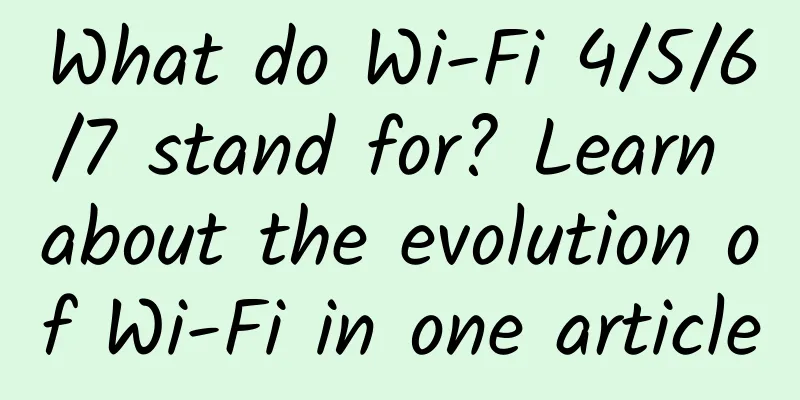What do Wi-Fi 4/5/6/7 stand for? Learn about the evolution of Wi-Fi in one article

|
Wi-Fi is the abbreviation of Wireless Fidelity. It was invented in the 1990s by Dr. John Sullivan (actually a research team led by Dr. John Sullivan and composed of graduates from the Engineering Department of the University of Sydney). In 1996, the Australian government research institution CSIRO successfully applied for a patent for wireless network technology in the United States.
On the eve of CES2022, MediaTek announced that it will demonstrate the next-generation Wi-Fi network technology, Wi-Fi 7, at CES2022. MediaTek said that Wi-Fi 7 is 2.4 times faster than Wi-Fi 6E, bringing faster speeds, lower latency, and enhanced anti-interference capabilities. As soon as the news came out, people could not help but sigh again, in an era when enterprise-side Wi-Fi 6 and consumer-side Wi-Fi 5 are not yet popular, Wi-Fi 7 is coming again. (Intel has previously revealed some matters about Wi-Fi 7) Although the word Wi-Fi has not changed, the technology behind it has been constantly evolving. Next, let's briefly talk about the evolution of Wi-Fi. The Evolution of Wi-FiIn 1971, the ALOHA network was the world's first wireless network (wireless data network), and the ALOHA protocol it developed was a forerunner of the IEEE 802.11 protocol; In 1985, the U.S. Federal Communications Commission (FCC) announced the 2.4GHz network frequency band; in 1996, the Australian government research institute CSIRO applied for a Wi-Fi patent; In 1997, the Institute of Electrical and Electronics Engineers (IEEE) launched the first generation of WLAN protocol, namely IEEE 802.11, which stipulates that wireless LANs operate at 2.4GHz with a maximum rate of 2Mbps. In 1999, IEEE launched 802.11a at 5GHz with a maximum rate of 54Mbps. Subsequently, IEEE launched 802.11b at 2.4GHz with a maximum rate of 11Mbps. In the same year, the Wi-Fi Alliance was established and replaced 802.11b with the word Wi-Fi, which was more commercialized. In 2003, IEEE developed the third generation Wi-Fi standard, 802.11g, which integrated 802.11b and 802.11a and increased compatibility; In 2009, IEEE formulated the 802.11n standard, namely Wi-Fi 4, which introduced MIMO technology. The theoretical maximum transmission speed is 600Mbps, which is a significant improvement over the previous 54Mbps, and the transmission distance will also increase; In 2013, Wi-Fi 5 was released, namely 802.11ac, which uses the 5GHz frequency band, with a maximum rate of 867Mbps for a single antenna and a theoretical maximum rate of 6.9Gbps; In 2019, the Wi-Fi 6 standard was formulated, namely 802.11ax, which uses 2.4GHz and 5GHz frequency bands, with a maximum single stream of 1201Mbps and a maximum rate of 9.6Gbps; In 2020, Wi-Fi 6E was launched, adding the 6GHz band. It is an upgraded version of Wi-Fi 6, allowing routers to include a new frequency band in addition to 2.4GHz and 5GHz. Wi-Fi 7 Standards Roadmap / IEEE In 2021, the Wi-Fi 7 1.0 standard was launched, also known as 802.11be. Wi-Fi 7 can provide wireless connection rates of more than 30Gbps, which is about 3.6 times that of Wi-Fi 6. The bandwidth is increased from 160MHz to 320MHz, and the latest open 6GHz band support is introduced (supporting up to 3 non-overlapping 320MHz channels in the range of 5.925GHz~7.125GHz), and it is backward compatible with 2.4GHz and 5GHz. The MIMO (multi-user input and output) design doubles the number of spatial streams from a maximum of 8 to 16. However, the official version of Wi-Fi 7 has not been made public. The Wi-Fi Alliance expects to finalize it between November 2023 and May 2024, when related products will be officially released. summary:Wi-Fi technology is constantly being upgraded and new versions are constantly being released, but you don't have to worry about compatibility. Generally, the latest Wi-Fi standards are backward compatible and can be used normally on conventional devices. In addition, when using free Wi-Fi, please be cautious and try to avoid online shopping or online banking operations under public Wi-Fi; at the same time, regularly change your home wireless password and increase the difficulty of the password; if possible, ensure that each Internet device is installed with security protection software, especially PC devices. |
<<: If you don’t know NAT, you can’t be a good network engineer
>>: WiFi 7 will have these improvements with a speed 2.4 times faster than WiFi 6
Recommend
DediPath Fall Promotion: 40% off all VPS/Hybrid Servers in Los Angeles, starting at $39 per month for dedicated servers
DediPath is a foreign VPS service provider founde...
SD-WAN & SASE market grew 30%, but what are the challenges behind it?
According to the latest "SASE & SD-WAN &...
Starlink banned from service in India until it gets internet license
SpaceX hasn't always received a warm welcome ...
Dish signs 10-year AT&T network service deal worth $5 billion
US satellite TV operator Dish Network has signed ...
Ubuntu 18.04 changes the IP address
My memory is getting worse and worse, just record...
Interview Question Series: 12 Deadly Questions on Network
1. What is your understanding of the TCP/IP four-...
Data Center Network Security Checklist Must-Haves
The cyber threat landscape is changing faster tha...
HostYun: Hong Kong CN2 GIA line Tsuen Wan data center AMD high-performance VPS monthly payment starting from 19.8 yuan
HostYun has added a new VPS product in Hong Kong&...
CrownCloud: Los Angeles AMD Ryzen KVM special price starts at $30 per year
In April this year, CrownCloud launched the AMD R...
RAKsmart: Korean VPS starting from $3.5 per month, 1GB/25GN SSD/5M bandwidth/Seoul data center
The blog often shares information about RAKsmart&...
The current status of 5G and new initiatives of the three major telecommunications operators
After entering 2021, the movement of 5G construct...
iOVZ VPS in March 20% off monthly payment and 30% off annual payment, South Korea/Los Angeles data center available
iOVZ Cloud has launched a regular promotion in Ma...
5G phones have been available for three years. Why is 5G in the United States so slow? Three major problems remain unsolved
Since the advent of 5G technology, U.S. wireless ...
How to Understand Fog Computing and Edge Computing in Simple Terms
Over the past few decades, there has been a huge ...
Don’t just focus on SD-WAN, pay attention to IPv6
The Internet of Things (IoT) is fundamentally cha...









